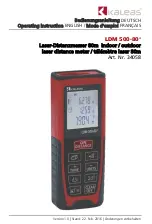
10 TEGAM WAY • GENEVA, OHIO 44041
440-466-
6100 • FAX 440
-466-
3-2
Section III
–
Principles of Operation
Theory of RF Power Measurements
Principles of DC Substitution
Power sensors are not ideal devices, so in order to make good measurements they must be
characterized and corrected for. DC substitution is the key for precise RF power
measurements. The Model 1830A uses the principle of DC substitution to measure RF power.
DC substitution refers to the measurement of RF power according to the amount of DC
power that must be substituted for the RF power in a bolometer in order to cause equivalent
thermal effects. This is done by monitoring voltage changes of the 1830A’s sel
f-balancing
bridge circuits.
Power Measurements
The Model 1830A RF Power Meter makes measurements based on a 4-wire technique. The
reference resistor R
Ref
is used to monitor a constant current source that heats the RF
sense thermistors in the sensor. Separate sense leads monitor the voltage drop across
the thermistors. An error amplifier compares the difference between the voltage drop of
R
Ref
and the voltage drop of the sense thermistors to regulate the constant current source
and acts to keep the resistances equal. Once R
Ref
and the resistance of the sensor are
equivalent, the change in the value of V
RRef
is proportional to the RF energy incident on
the sensor.
As RF enters the sensor the constant current source keeps the sensor resistance = R
Ref
by
reducing amount of DC current applied. The Voltage output V
RRef
is then fed into a
programmatic gain amplifier where there is an offset adjustment as shown in Figure 3.1.
The ZERO function is also utilized in this section, when the RF power is off (no power at
sensor) the offset adjustment creates a voltage that maintains a constant zero reference
point (0mW). Once a RF signal is applied the A/D calculates power based on the reference
ZERO level.
Figure 3.1 - Basic 1830A RF Power Measurement Diagram
















































